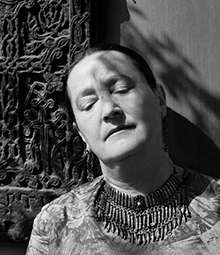Mariam Aslamazian
Mariam Arshaki Aslamazian (Russian: Асламаз́ян Мариа́м Арша́ковна; Armenian: Մարիամ Ասլամազյան; 20 October 1907 – 16 July 2006) was a Soviet painter, recognized as a People's Artist of the Armenian SSR (1965) and People's Artist of the Soviet Union (1990).
Mariam Aslamazian | |
|---|---|
 | |
| Born | 20 October 1907 |
| Died | 16 July 2006 (aged 98) |
Born in Alexandropol (today Gyumri), Aslamazian has been referred to as the "Armenian Frida Kahlo"[1] due to her depictions of traditional Armenian culture, her bright, modernist palette, eclectic personal style, and self-portraits depicting herself in traditional Armenian dress. She also enjoyed a successful career as an independent woman artist working in a male-dominated profession in the mid-twentieth-century.
Aslamazian was the student of Stepan Aghajanian and Petrov-Vodkin and is a representative of the Armenian school of decorative-planar still life paintings and portraits, as well as an accomplished ceramicist. The saturated colors, flattened space, and decorative motifs of Aslamazian's paintings reflect a variety of influences, including Western modernists Henri Matisse and Paul Cézanne and the earlier Armenian avant-garde which included such seminal painters as Martiros Saryan. She also painted overtly Socialist Realist work, which was required of Official artists of the day, most notably The Return of the Hero (1943) for which she was awarded the Medal "For the Defence of the Caucasus."[2]
Aslamazian enjoyed a successful career in the Soviet system, earning recognition through official channels. She received funding through the Artists' Union to travel to numerous countries around the world, including Algeria, Argentina, Belgium, China, German Democratic Republic (today Germany), France, India, Italy, Japan, Madagascar, Spain, Sweden, the Netherlands, United Arab Republic (today Egypt and Syria), and Yugoslavia.[3] In 1957, the Soviet government sent her on an officially sanctioned trip to India to help to establish friendly diplomatic ties between the two countries.[4] An exhibition was mounted at the end of her trip to showcase the paintings she'd created during her time in the country which was attended by Indira Gandhi, who also appeared in some of the paintings. This and three subsequent trips in 1970, 1973, and 1975, played a significant role in establishing positive Indo-Soviet diplomatic ties.[5]
The Gallery of Mariam and Eranuhi Aslamazyan Sisters, located in the sisters' hometown, holds a large collection of their works in oil and ceramic which are on permanent display. Her sister, Yeranuhi Aslamazian, was also an artist. Aslamazian's work is held in the National Gallery of Armenia[6] and in the Derfner Judaica Museum.[7]
Aslamazian died in Moscow and was buried in Yerevan's Komitas Pantheon. In recent years, there has been a resurgence of interest in Aslamazian's work and her paintings have been featured in contemporary exhibitions.[8]
References
- Mirror-Spectator, The Armenian (17 August 2018). "The Armenian Frida Kahlo: On Mariam Aslamazyan's 110th Anniversary". The Armenian Mirror-Spectator. Retrieved 18 July 2019.
- "Mariam Aslamazyan". www.aslamazyanmuseum.com. Retrieved 18 July 2019.
- "Асламазян, Мариам Аршаковна", Википедия (in Russian), 11 November 2018, retrieved 18 July 2019
- / 'Three Monologues', retrieved 18 July 2019
- "india-armenia | Sunny India of the Aslamazyans-An Exhibi". Indo-Armenian Friendship Հնդկաստան India Caucasus, Armenians in India. Retrieved 18 July 2019.
- "Painting - Armenian - Collection - National Gallery of Armenia". www.gallery.am. Retrieved 18 July 2019.
- "Aslamazian, Mariam". artathhar.pastperfectonline.com. Retrieved 28 July 2019.
- Sputnik. "Двадцать лет спустя: в Москве выставлены "солнечные" картины Мариам Асламазян". Sputnik Армения (in Russian). Retrieved 18 July 2019.
Sources
- Pilosyan, Syuzanna (2007). Mariam Aslamazian. Amrots Publishing. ISBN 978-99941-31-49-5.
- Bown, Matthew Cullerne (1993). "Painting in the non-Russian Republics". In Art of the Soviets: Painting, Sculpture and Architecture in a One-party State, 1917-1992. Manchester University Press. ISBN 978-0719037351.
External links
- Official website for The Gallery of Mariam and Eranuhi Aslamazyan Sisters
- Mariam Aslamazian in Great Soviet Encyclopedia
- RA Prime Minister Sends Message of Condolence on Occasion of Death of Mariam Aslamazian, July 26, 2006
- Mariam Aslamazian in ArtPanorama Gallery
- Mariam Aslamazian in the Encyclopedia of Hayazg